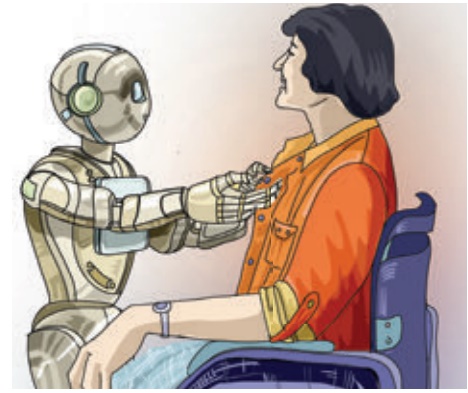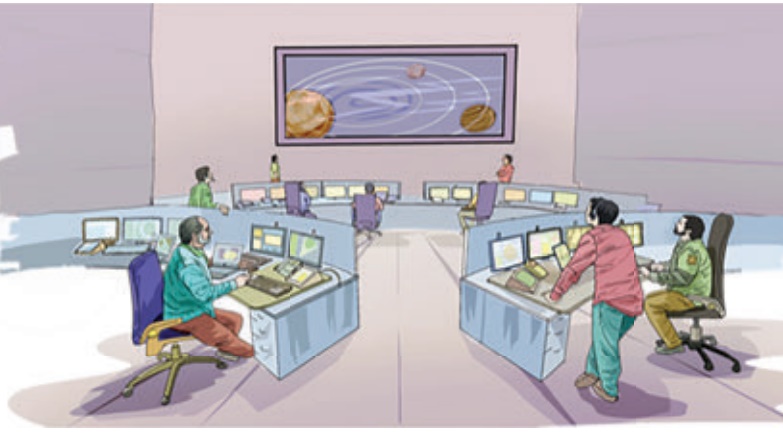by Jules Verne | Supplementary/Story - A day in 2889 of an American Journalist | 10th English: UNIT 5 : Supplementary/Story: A day in 2889 of an American Journalist
Chapter: 10th English: UNIT 5 : Supplementary/Story: A day in 2889 of an American Journalist
A day in 2889 of an American Journalist
Supplementary
A day in 2889 of an American Journalist
Jules Verne
This story speaks about the people of the twenty-ninth century
who live in fairyland. Surfeited as they are with marvels, they are indifferent
to the presence of each new marvel. To them all seem natural.
The year is 2889, the date 25th July and the place is the office
block of the Managing Editor of the Earth Herald, the world’s largest
newspaper.
In this futuristic story written in 1889, the writer describes how
he visualizes the world a thousand years later – a world of technological
advancements where newspapers are not printed but ‘spoken’.
Read the following excerpt for a glimpse of this future world.
That morning Francis Bennett awoke in rather a bad temper. This
was eight days since his wife had been in France and he was feeling a little
lonely. As soon as he awoke, Francis Bennett switched on his phonotelephote whose wires led to the house he owned in the Champs-Elysees.

The telephone, completed by the telephote, is another of our
time’s conquests! Though the transmission of speech by the electric current was
already very old, it was only since yesterday that vision could also be
transmitted. A valuable discovery, and Francis Bennett was by no means the only
one to bless its inventor when, in spite of the enormous distance between them,
he saw his wife appear in the telephotic mirror. ‘Francis … dear Francis!...’

His name, spoken by that sweet voice, gave a happier turn to
Francis Bennett’s mood. He quickly jumped out of bed and went into his
mechanized dressing room. Two minutes later, without needing the help of a valet, the machine deposited
him, washed, shaved, shod, dressed and buttoned from top to toe, on the
threshold of his office. The day’s work was going to begin.
Francis Bennett went on into the reporters’ room. His fifteen
hundred reporters, placed before an equal number of telephones, were passing on
to subscribers the news which had come in during the night from the four
quarters of the earth. In addition to his telephone, each reporter has in front
of him a series of commutators, which allow him to get into communication with this or that
telephotic line.
Thus the subscribers have not only the story but the sight of
these events.
Francis Bennett questioned one of the ten astronomical reporters –
a service which was growing because of the recent discoveries in the stellar
world.
‘Well, Cash, what have you got?’
‘Phototelegrams from Mercury, Venus and Mars, Sir.’
‘Interesting! And Jupiter?’
‘Nothing so far! We haven’t been able to understand the signals
the Jovians make. Perhaps ours haven’t reached them? ….’
‘Aren’t you getting some result from the moon, at any rate?’
‘Not yet, Mr Bennett.’
‘Well, this time, you can’t blame optical science! The moon is six
hundred times nearer than Mars, and yet our correspondence service is in
regular operation with Mars. It can’t be telescopes we need…’
‘No, it’s the inhabitants,’ Corley replied.
‘You dare tell me that the moon is uninhabited?’
‘On the face it turns towards us, at any rate, Mr Bennett. Who
knows whether on the other side…’
‘Well, there’s a very simple method of finding out.’

‘And that is?’
‘To turn the moon round!’
And that very day, the scientists of the Bennett factory started
working out some mechanical means of turning our satellite right round.
On the whole, Francis Bennett had reason to be satisfied. One of
the Earth Herald’s astronomers had just determined the elements of the new
planet Gandini. It is at a distance of 12,841,348,284,623 metres and 7
decimetres that this planet describes its orbit round the sun in 572 years, 194
days, 12 hours, 43 minutes, 9.8 seconds. Francis Bennett was delighted with
such precision.
‘Good!’ he exclaimed. ‘Hurry up and tell the reportage service
about it. You know what a passion the public has for these astronomical
questions. I’m anxious for the news to appear in today’s issue!’
The next room, a broad gallery about a quarter of a mile long, was
devoted to publicity, and it well may be imagined what the publicity for such a
journal as the Earth Herald had to be. It brought in a daily average of three
million dollars. They are gigantic signs reflected on the clouds, so large that
they can be seen all over a whole country. From that gallery a thousand
projectors were unceasingly employed in sending to the clouds, on which they
were reproduced in colour, these inordinate advertisements.
At that moment the clock struck twelve. The director of the Earth
Herald left the hall and sat down in a rolling armchair. In a few minutes he
had reached his dining room half a mile away, at the far end of the office.
The table was laid and he took his place at it. Within reach of
his hand was placed a series of taps and before him was the curved surface of a
phonotelephote, on which appeared the dining room of his home in Paris. Mr and
Mrs Bennett had arranged to have lunch at the same time – nothing could be more
pleasant than to be face to face in spite of the distance, to see one another
and talk by means of the phonotelephotic apparatus.

Like everybody else in easy circumstances nowadays, Francis
Bennett, having abandoned domestic cooking, is one of the subscribers to the
Society for Supplying Food to the Home, which distributes dishes of a thousand
types through a network of pneumatic tubes. This system is expensive, no doubt,
but the cooking is better. So, not without some regret, Francis Bennett was
lunching in solitude. He was finishing his coffee when Mrs Bennett, having got
back home, appeared in the telephote screen.
When he had finished his lunch, he went across to the window,
where his aero-car was waiting.
‘Where are we going, Sir?’ asked the aero-coachman. ‘Let’s see.
I’ve got time…’ Francis Bennett replied. ‘Take me to my accumulator works at
Niagara.’
The aero-car shot across space at a speed of about four hundred
miles an hour. Below him were spread out the towns with their moving pavements
which carry the wayfarers along the streets, and the countryside, covered, as
though by an immense spider’s web, by the network of electric wires.

Within half an hour, Francis Bennett had reached his works at
Niagara, where, after using the force of the cataracts to produce energy, he
sold or hired it out to the consumers. Then he returned, by way of
Philadelphia, Boston and New York, to Centropolis, where his aero-car put him
down about five o’clock.
The waiting-room of the Earth Herald was crowded. A careful
lookout was being kept for Francis Bennett to return for the daily audience he
gave to his petitioners. Among their different proposals he had to make a
choice, reject the bad ones, look into the doubtful ones, and welcome the good
ones.
He soon got rid of those who had only useless or impracticable
schemes. A few of the others received a better welcome, and foremost among them
was a young man whose broad brow indicated a high degree of intelligence.
‘Sir’, he began, ‘though the number of elements used to be
estimated at seventy-five, it has now been reduced to three, as no doubt you
are aware?’
‘Perfectly,’ Francis Bennett replied.
‘Well, Sir, I’m on the point of reducing the three to one. If I
don’t run out of money I’ll have succeeded in three weeks.’
‘And then?’
‘Then, Sir, I shall really have discovered the absolute’.
‘And the results of that discovery?’
‘It will be to make the creation of all forms of matter easy –
stone, wood, metal, fibrin ….’
‘Are you saying you’re going to be able to construct a human
being?’
‘Complete… The only thing missing will be the soul!’
Francis Bennett assigned the young fellow to the scientific
editorial department of his journal.
A second inventor, using as a basis some old experiments that
dated from the 19th century, had the idea of moving a whole city in a single
block. He suggested, as a demonstration, the town of Saaf, situated fifteen
miles from the sea; after conveying it on rails down to the shore, he would
transform it into a seaside resort. Francis Bennett, attracted by this project,
agreed to take a half-share in it.
The proposals heard and dealt with, Francis Bennett went to
stretch himself out in an easy-chair in the audition-room. Then, pressing a
button, he was put into communication with the Central Concert. After so busy a
day, what charm he found in the works of our greatest masters, based on a
series of delicious harmonico-algebraic formulae! During his meal, phonotelephotic
communication had been set up with Paris.
‘When do you expect to get back to Centropolis, dear Edith?’ asked
Francis Bennett.
‘I’m going to start this moment’.
‘By tube or aero-train?’
‘By tube’.
‘Then you’ll be here?’
‘At eleven fifty-nine this evening’.
‘Paris time?’
‘No, no! … Centropolis time’.
‘Goodbye then, and above all don’t miss the tube!’
These submarine tubes, by which one travels from Paris in two
hundred and ninety-five minutes, are certainly much preferable to the
aero-trains, which only manage six hundred miles an hour.
Francis Bennett, very tired after so very full a day, decided to
take a bath before going to bed. There was always a bath already in the office.
He touched the button. A rumbling sound began, got louder, increased … Then one
of the doors opened and the bath appeared, gliding along on its rails …
About the author
Jules Verne (1828–1905) was a French poet, playwright and novelist but he earns his place on this list of great
writers because of his futuristic
adventure novels. He has been called the father of science fiction and
has had an incalculable influence on the phototelegrams (n): a telegraphic
development of science fiction writing. More interesting, perhaps, is his place
as a prophet or predictor of technology which wasn’t to be invented until long
after his death. He put a man on the moon, including its launch from a Florida
launchpad to its splashdown in the Pacific; in 1863 he predicted the internet:
Paris in the 20th Century (1863) depicts the details of modern life:
skyscrapers, television, Maglev trains, computers, and a culture preoccupied
with the Internet.

Related Topics